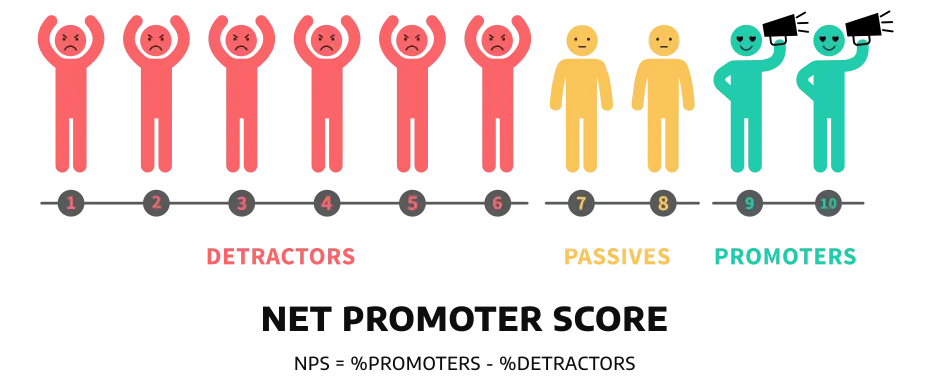Customers are the lifeblood of every SaaS business, and yet it can be hard to know exactly what they are thinking. In an ideal world, your company would be able to find out the customers who are willing to promote your business, and identify those at-risk customers who are about to churn.
The good news is there is a fairly easy way to discover customer sentiment about your business. Sending out a Net Promoter Score® survey either in-app or through email helps you understand the opinion your customer has of your business and set you up to take appropriate action.
Unfortunately, gathering NPS data isn’t as simple as designing a survey and hitting send. There is a process you need to go through which we’ll be discussing in this post.
What is Net Promoter Score?
Net Promoter Score is a single-question survey devised by Bain & Company in 2003 that usually goes something like this:
“How likely are you to recommend [company/product] to a friend, relative or colleague”?
What makes NPS unique is that customers answer this question on a scale of 1 to 10, with 1 being “highly unlikely” and 10 being “very likely”. The responses are then grouped into categories which are Promoters (very likely to recommend), Passives (neutral about your business) and Detractors (highly unlikely to recommend your business).
NPS is a measure of customer loyalty and helps you discover whether a customer is willing to promote your brand. How a customer responds to your NPS survey then influences any follow-up activity you might want to take.

You calculate Net Promoter Score by subtracting the percentage of Detractors from the percentage of Promoters, as follows:
Net Promoter Score = (Promoters/Total Respondents x 100) – (Detractors/Total Respondents x 100)
What are the Benefits of Net Promoter Score?
It’s easy to complete
Since the NPS survey is usually composed with a simple “would you recommend” question along with a follow-up question to capture qualitative data, it’s easy for customers to complete. This relative ease means customers are more likely to answer your survey, significantly enhancing the quality of data you’re able to collect.
It measures customer loyalty
NPS surveys tell you how loyal customers are to your business, so you’re able to find out which customers are likely to keep purchasing your SaaS product. This is helpful in predicting revenue and overall business growth.
It helps decrease churn
Since you can find out who your most unhappy customers are, it enables you to take action to reduce customer churn before it is too late. Your Detractors are those customers who are unlikely to recommend your business, perhaps due to a bad service experience or poor understanding of your product’s features.
Best Practices for Net Promoter Score Implementation
1. Get buy-in from your organization
Net Promoter Score is not something that your customer success team can decide to implement without reference to the rest of the business. Most importantly, you need buy-in from senior leadership to help establish processes for acting on your NPS feedback, especially for implementing large scale changes that you discover you need.
2. Choose the right software for surveys
Software like Churn360’s NPS survey software allows you to easily create NPS surveys for sending out to your customers. You can send it either through email or as an in-app notification, depending on the needs of your business. This real-time feedback and insights from your customers can be included in your health score, which gives a helpful prediction of potential churn.
3. Design an engaging survey
Your NPS survey should be appealing to customers and include an engaging scale that customers can complete to answer your question.
Include a relevant follow-up question that encourages your customers to elaborate on the rating they have given your business. You can tailor the question depending on what rating the customer has provided, and so gather different information based on whether they are Promoter, Passive or Detractor.
Schedule a demo with one of our experts to take a deeper dive into Churn360
Book a demo
4. Send the survey at an appropriate time
It’s no good sending NPS surveys to your customers when they are deeply engaged with using a feature, or when they haven’t had much of a chance to use your software yet. You need to be strategic in assessing when to send your NPS survey – for example, a good time to send an NPS survey could be a day after the customer has completed your free trial.
5. Close the loop with customers
Sending out automated responses to customers who have completed your NPS can be useful in letting them know that their feedback has been received. However, you shouldn’t stop there – personally following up with every customer is critical if you want to close the loop on your NPS survey. For example, jumping on the phone with your Detractors to remedy their negative is crucial in preventing churn.
6. Make strategic changes
The whole point of conducting your NPS survey is to identify key changes that you can make in your business that will result in your current and future customers being happier. Only 1 out of 26 customers complain – the rest just churn. So if you’re repeatedly getting feedback that a feature is hard to use, you can be sure that many more customers are suffering from the same problem. That’s why your follow-up question is so important when you’re sending out your NPS survey.
7. Involve other teams in acting on feedback
Although it may be your customer success team that is directly involved in gathering and responding to NPS feedback, you need to create valuable links between teams that empower your business to act on the survey responses. For example, your product team needs to be looped in on requests for new features, and your customer support team needs to be made aware when customers have interactions that could be improved.
Wrapping Up
Keeping a close eye on how customers feel about your business is an important way to make strategic improvements to your product and service. If you take the time to ask customers to respond to a simple NPS survey, you’ll probably discover that many of them are willing to share their thoughts on what they like and dislike.
Promoters are customers who can provide a vital resource for recommendations, testimonials and reviews. Passives are customers who might just need a little persuasion to become a Promoter. Finally, Detractors are your greatest source of learning, because they’ll share when your business has let them down and offer constructive criticism.


